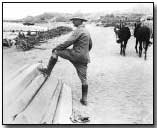Who's Who - Sir William Birdwood
 Affectionately known as 'Birdy' by the
Australian troops, Sir William Birdwood (1865-1951) led the Australian and
New Zealand Army Corps - the ANZACs - from 1914 almost to the end of the war in
1918, during which time Birdwood himself received numerous promotions,
despite antipathy from the British Commander in Chief,
Sir Douglas Haig.
Affectionately known as 'Birdy' by the
Australian troops, Sir William Birdwood (1865-1951) led the Australian and
New Zealand Army Corps - the ANZACs - from 1914 almost to the end of the war in
1918, during which time Birdwood himself received numerous promotions,
despite antipathy from the British Commander in Chief,
Sir Douglas Haig.
One of the few men to come out of the Gallipoli fiasco with his reputation intact (where, to his surprise, Birdwood and his forces were placed under the direction of General Hamilton).
Birdwood's indulgent style of leadership - he was a genial man, though well-aware of the benefits attached to his reputation - endeared him to the men under him. Indeed, Birdwood's popularity engendered a good deal of suspicion in Haig, who suspected that Birdwood achieved popularity at the expense of discipline.
Having established his career as an Indian Army officer - born in Bombay, Birdwood was a protégé of Lord Kitchener - Birdwood had not led so much as a division prior to the somewhat surprising decision to award him command of the ANZAC forces. Birdwood generally left the day to day running of his forces to his chief of staff, the Australian Brudenell White.
Birdwood was promoted lieutenant-general in August 1915, shortly before he was knighted the same year. Made a full general by virtue of Indian Army service in 1917, he remained with the ANZAC forces when they were transferred to the Western Front in 1916 until, in May 1918, he was handed command of Fifth Army, leading them through the crucial Courtrai Offensive in the Autumn of 1918. Brudenell continued to effectively manage Birdwood's forces day to day. Sir John Monash was meanwhile given command of the ANZACs.
Although generally treated kindly by history, Birdwood attracted some criticism both at the time and afterwards. Birdwood's leadership style was directly cited by Pompey Elliott as a cause of the Australians' defeats in 1916/17, notably at Bullecourt. Elliott further ventured to suggest that Birdwood's liking for the Australians was affected, and that he actually regarded their democratic instincts with suspicion.
After the armistice Birdwood returned to India where he commanded the Northern Army. He became Commander in Chief there in 1925, retiring five years later. He died in 1951.
A cartwheel was a particular type of aerial manoeuvre.
- Did you know?
